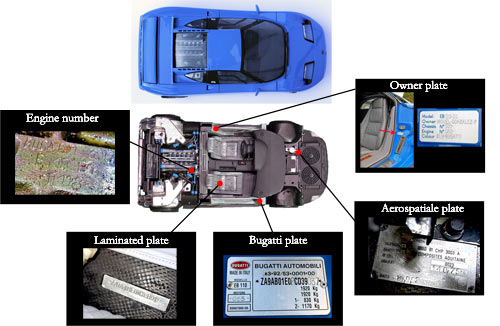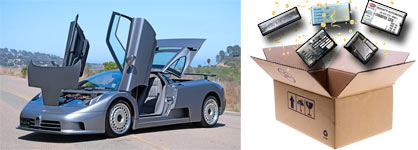| A Bugatti EB110 is not an easy car to identify at first glance. The minimalist color palette, the reduced interior choices and the predominance of the two presentation colors (Bugatti Blue and Light Grey) lead to many similar configurations. More, the EB110 is not readily to reveal : all identification numbers are cleverly hidden from the eyes. |
Each Bugatti EB110 is unique and identified at different levels. There are no less than 5 devices to identify a car : - its Bugatti chassis number (called VIN, for Vehicule Identification Number), - sometimes an identification plate of the owner, - its engine number, - a reminder of the chassis number under the passenger seat, - finally, an identification of the carbon chassis manufactured by the Aerospatiale company, with a Bugatti Automobili internal number added manually to this plate, called the Scocca. |
| None of these numbers are easy to access, some more than others. |
 |
 |
 |
| The Vehicule Identification Number (VIN) is a kind of first name that allows to make the distinction between vehicule of the same model. EB110s cars were built with a metallic Bugatti plate, engraved with the VIN of the car. This Bugatti plate is located on the wheel arch, at the passenger side. The following information is available : model type (Modello : EB110 or EB110SS), engine number (Motore) and VIN. |
| How to read the EB110 VIN? |
 |
| It is quite easy finally, only few numbers are important to identify a car : the model identification (01 for GT, 02 for SS) and the last 3 digits (the number of the car). Concerning the year identification letter, the correspondance is : M : 1991, N : 1992, P : 1993, R : 1994, S : 1995. The GT and the SS were numbered separetely and the both started at number 001. The last GT recorded is the GT102 and the last SS recorded is the SS40 (unfinished at the bankruptcy). |
| Country and engine codes informations can be summarized as followed: |
| Model
type |
Car identification |
VIN |
Engine code |
| EB 110 GT (European Union) | 110.A | ZA9AB01E0_CD39_ _ _ | B110.00 |
| EB 110 GT (Switzerland - Austria - Sweden) | 110.AC | ZA9AB01S0_CD39_ _ _ | B110.02 |
| EB 110 GT (Saudi Arabia - Persian gulf) | 110.AG | ZA9AB01G0_CD39_ _ _ | B110.00 |
| EB 110 GT (Japan) | 110.AD | ZA9AB01J0_CD39_ _ _ | B110.03 |
| EB 110 GT (USA) | 110.AE | B110.06 | |
| EB 110 SS (European Union) | 110.B | ZA9BB02E0_CD39_ _ _ | B110.01 |
| EB 110 SS (Switzerland - Austria - Sweden) | 110.BC | ZA9BB02S0_CD39_ _ _ | B110.04 |
| EB 110 SS (Saudi Arabia - Persian gulf) | 110.BG | ZA9BB02G0_CD39_ _ _ | B110.01 |
| EB 110 SS (Japan) | 110.BD | ZA9BB02J0_CD39_ _ _ | B110.05 |
| EB 110 SS (USA) | 110.BE | ZA9CB02U_ _CD39_ _ _ | B110.07 |
| EB 110 Racing Version | 110.R | ||
| EB 110 GT Special Version (for instance Brunei) EB 110 SS Special Version |
110.AZ 110.BZ |
 |
 |
The owner plate is an optional indication located near the driver's door latch system. It contains
the model type (EB110 GT or EB110 SS), the
name of the first owner,
the chassis and engine numbers, and
the original color. Only few cars have this owner plate and it is not always dated to the construction of the car, they may have been affixed post-assembling. |
 |
 |
| The laminated plate is a metal plate located under the passenger seat, you need to move the seat forward as much as you can to see it. This plate repeats the complete VIN, glued in a nick of the carbon structure of the Aerospatiale chassis. The absence of laminated plate is the sign of a car with a more exotic history (prototype, reconstruction ...). |
 |
 |
The
Aerospatiale company has designed the chassis and entrusted the manufacture to Composites Aquitaine. A plate, located under the front bonnet near the headlight, on the driver side, gives the number of the carbon chassis (Bugatti called it the TELAIO), the weight of the chassis and the date of manufacture. Once in Campogalliano, a worker engraved manually the number of the car of destination. This destination number is not the chassis number, it is an internal number, that correspond to a body shell number. Bugatti called it the SCOCCA . For the Supersport model, it is rather simple to understand the scocca : this number is the two last digit of the chassis number, preceded by the letter S (for Supersport). For GT, the scheme is still not deciphered. The scocca number is a two or three digits, that is NOT the chassis number. The scocca number is not parallel to the VIN number but is increasing as production progresses, while not being perfectly linear. |
 |
 |
The engine number is difficult to reach because it is engraved on a small flat surface of the engine block, which is found under a set of cables and pipes once the engine in place. |
 |
 |
There is another number well hidden in an EB110, but so far only on Supersport models. Located in the lower left aeration of the panel between the rear lights, a metal plate on the cross beam is visible through the grille. On this plate, on the top right, is engraved the scocca number of the car. |
 |
 |
Cars built by Dauer could be unfinished Bugatti cars (SS24, SS29 and SS36) or completely new EB110s. Unfinished car are homologated by Bugatti and carry a classic Bugatti VIN. The exception is the S36, splitted with the documents on one side and the car on the other one. The car used a fake Bugatti number, with the telaio number (#137) instead the chassis numbered (SS36). |

